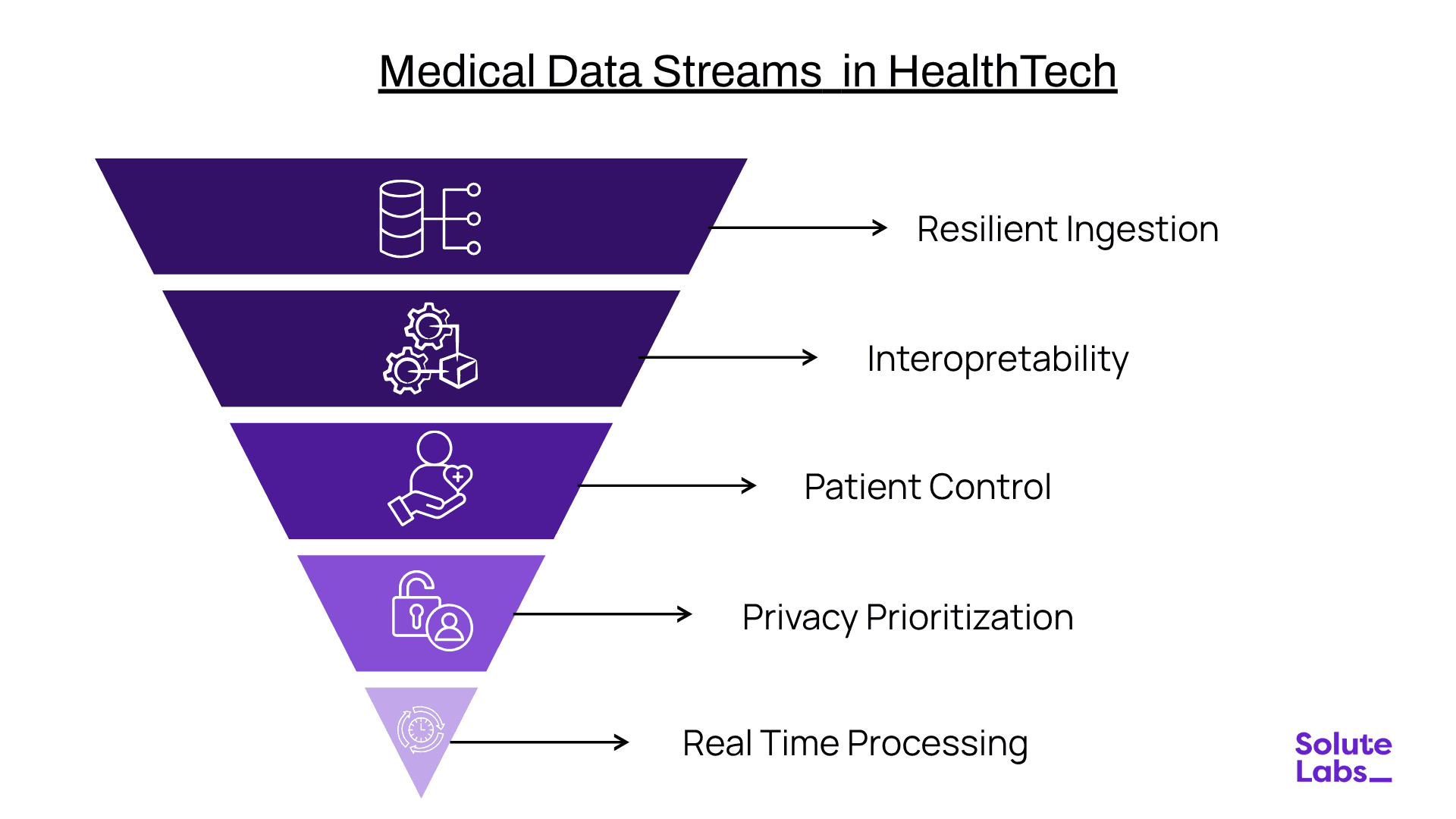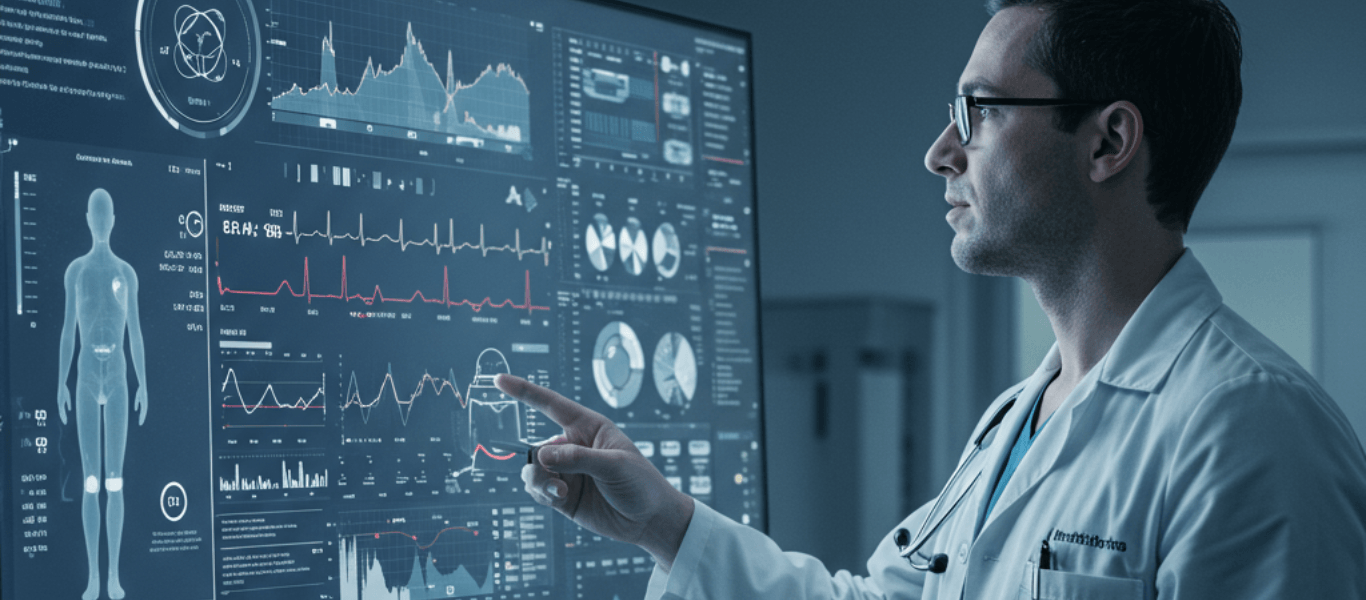Medical data streams transmit information constantly and in real time from various healthcare technologies. For instance, the fitness app on your smartphone that shows your step count receives a medical data stream from your Fitbit or any other wearable device.
Other health technologies that generate medical data streams include vital monitors and implantable devices.
These data streams help healthcare providers, such as doctors and clinicians, to provide better, more personalized, and timely support to their patients. At the same time, patients and health-conscious individuals can rely on these data streams to improve their physical and mental well-being.
Modern HealthTech software products fetch a vast volume and variety of medical device data from multiple sources. Electronic health records, intensive care devices, and manual inputs. This enriches a person’s health information, enabling them to receive better care.
However, each medical data stream is unique. The format of data, frequency of update, number of parameters in each dataset, and volume differ significantly.
This makes data integration and interpretation challenging, leading to healthcare interoperability issues.
Doctors, for example, will struggle to fill gaps in a patient’s record. They can
find it difficult to administer the right treatment with confidence. Individual users can make mistakes due to unreliable data. And most importantly, you can face compliance issues.
In this article, let’s look at how you can manage multiple medical data streams in your HealthTech app.

1. Develop a Resilient Ingestion Architecture
An ingestion architecture captures data from medical and healthcare devices reliably and safely.
This foundation of efficient medical-data management keeps collected data correct, adequate, and accurate while adhering to privacy and security regulations.
Key considerations when building a resilient ingestion architecture for your HealthTech app are availability, scalability, and fault tolerance.
The system must work around the clock to record all new data points. It should be scalable to address growing healthcare data management needs. Finally, the data stream should remain safe and unadulterated during transmission, even during momentary disruptions caused by issues such as weak network connections and API failures.
From a development standpoint, you can consider standardized data protocols, such as HL7 and FHIR, that work with widely used digital health records. Additionally, this will help you stay compliant with global digital healthcare regulations.
Then, use a cloud-based medical data streaming platform like Kafka or AWS Kinesis. They can handle high volumes of data effortlessly and scale up as needed. The system also processes data in real time, instantly making the information available to the user for analytics.
You can incorporate other techniques, such as retries and dead-letter queues, to spot anomalies in datasets and avoid silent failures proactively.
2. Think of Interoperability From the Start
Medical data streams, regardless of their origin, are used in different healthcare systems. Patients, for instance, access their records through HealthTech apps, and doctors can access the data through electronic health records (EHRs).
Interoperability ensures that this occurs smoothly. It unifies the information collected by different medical data devices and makes it accessible through all connected healthcare systems.
This is critical because, in the era of digital healthcare, medical organizations collect siloed data across incompatible devices and store it in inconsistent formats.
Consequently, everyone using your HealthTech app, including clinicians, patients, and customers, can only view a part of the puzzle. It can lead to suboptimal treatment and monitoring of patients.
When developing healthcare software, build APIs that support structured data exchange between various medical systems. If you are picking proprietary solutions from the market, make sure their APIs are reliable by verifying their documentation.
Moreover, steer clear of data formats that restrict or complicate downstream interoperability. The goal is to collect and store medical device data in a way that users can use it to provide better care across devices. So, consider the nuances of all the potential devices and systems.
3. Give Control to Patients and Customers
Your users are sharing deeply personal and sensitive data when they use your HealthTech solutions and services. Hence, it’s natural for some of them to hesitate before trusting your organization with their medical information.
An effective way you can earn their trust is by giving them complete control over the healthcare data you collect. It means giving them permission to add, modify, or erase their medical records on their own terms.
This will align your HealthTech app with patient or user-centered care values, increasing brand affinity through transparency. Your users will view your services as ethical and feel respected and valued, increasing engagement.
Furthermore, you can bolster compliance with data privacy regulatory guidelines, such as HIPAA and GDPR, which emphasize patient rights around medical data streams.
A simple way to put it into practice is by developing an interface that lets your customers and users view patient data easily. Of course, place appropriate authentication and security measures. The interface can include dashboards and AI-generated summaries, based on your audience’s preferences.
Regarding control, make it easily accessible through the in-app settings. You can use toggles to enable granular control. The toggles can help your users choose which medical data streams you can collect and who can access them (doctors, caregivers, or third-party providers).
4. Prioritize Privacy From the Start
Hackers and cybercriminals usually target healthcare data due to its inherent value. Therefore, you have to take special care to ensure it stays protected from unauthorized access, use, or disclosure to protect your users and maintain public trust.
Additionally, unlike static patient records, medical device data streams are updated continuously, in real-time. This makes it critical for HealthTech app developers to consider privacy and safety from the ground up.
The first step in doing so involves visualizing data pipelines. Map how your medical device data system collects healthcare information from users and transfers it to other systems for later usage.
This will uncover various access points and medical device data transmission lines, making it easier for you to seal exposed endpoints and address potential vulnerabilities.
For preventing internal misuse, it’s critical to apply role-based access controls (RBAC) to limit who can view or edit the medical records of your customers. Another effective solution is to minimize data collection by collecting only necessary information and anonymizing wherever possible.
You can also build an internal team that oversees privacy policies centered around data security and transparency. This approach tests your HealthTech app’s medical-device data streams thoroughly at every stage, from development to live data transit.
5. Enable Real-Time Processing and Analytics
The ultimate objective of medical device data streams is real-time processing of healthcare information to generate actionable insights. It helps doctors and clinicians with the latest updates, enabling early detection and proper treatment.
Similarly, individual healthcare software users can track their own vitals and make more informed decisions that contribute to their well-being.
You can make it happen by adopting a reliable stream processing platform, such as Apache Kafka, Apache Flink, or cloud-based solutions like AWS Kinesis. As briefly mentioned earlier, these platforms can ingest and analyze huge amounts of healthcare data immediately.
Then, set rule-based triggers for biological vitals based on clinical thresholds. For instance, if a patient’s heart rate rises beyond 180, the medical device data system can trigger an alert, notifying their caregiver instantly.
To make the most out of real-time processing and analytics, you have to make sure that your employees, and where appropriate, patients, have the tools to turn raw data into insights. This can be made possible with large language models (LLMs).
Advanced AI models enable data analytics in natural language, making it easier for anyone, including non-technical users, to understand the live medical device data streams. It will also make your HealthTech apps more useful during emergencies due to the reduced time to insights.
SoluteLabs Will Help You Handle Medical Device Data Streams Effectively
You need to manage the medical device data streams from your users effectively and ethically to gain actionable insights, maintain public trust, and avoid legal penalties. When building the pipelines, you must consider all aspects, including ingestion, interoperability, compliance, patient empowerment, and real-time analytics.
Doing it in-house can be hectic. Maintaining an internal data management team, a tech stack, and comprehensive governance policies is tedious and time-consuming.
Additionally, scaling up your efforts around healthcare data stream management can be challenging. Your organization will need to hire the right personnel quickly to capitalize on the potential opportunities.
Partnering with seasoned professionals offers a better approach to handling medical-device data streams effectively.
SoluteLabs is an AI-native digital product engineering agency, specializing in developing advanced HealthTech applications that handle sensitive patient information. We can build you the data management pipeline you need.
Our tried-and-tested approach considers the growing needs of healthcare organizations to develop a scalable foundation for your medical device data streams. Of course, we ensure your systems remain interoperable, compliant, and secure, accelerating your platform’s adoption and upholding operational excellence.
Ready to streamline your medical device data strategy?
Contact us today for a personalized consultation call.







